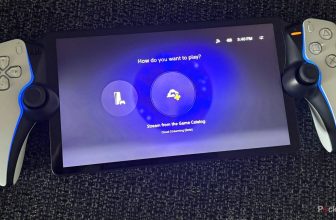Back when Switch 2 rumors started to swirl a few years ago, several reports hinted that Nintendo’s next handheld might feature a higher resolution screen, a more powerful chip, a revamped design, and other standard upgrades you’d expect from a next-gen handheld. While most of these rumors turned out to be true, there’s a key leak that didn’t become a reality.
At one point, several reliable reports indicated the Switch 2 could feature a dock designed to supercharge the Switch with a more powerful chip. This is what I’ve always wanted from a handheld-home console gaming device because it offers the best of both worlds and feels like a natural evolution of the original Switch. While we probably won’t get that kind of gaming experience from Nintendo any time soon, another company is keeping that dream alive.
This is where Asus’ undeniably price $2,500 USD ($3,500 CAD) ROG XG Mobile (2025) eGPU and the impressive, but flawed ROG Xbox Ally X come in.
Rather than run extensive benchmarks (which you can definitely find those on other tech publications) with this story, I’m focused on a broad overview of the ROG XG Mobile (2025) and what it’s actually like to use the eGPU with the ROG Xbox Ally X.
Along with the $2,500 USD ($3,500) XG Mobile Nvidia RTX 5090 laptop GPU with 24GB of GDDR7 VRAM, Asus also offers a USD $1,300 USD ($2,000 CAD) version that features a Nvidia GeForce RTX 5070 Ti laptop GPU and 12GB GDDR7 VRAM. If you’re planning to use the XG Mobile only with the Xbox Ally X, this lower-powered version might be the better option given Thunderbolt 4’s bandwidth limitations.
- Brand
- Asus
- GPU Included
- NVIDIA RTX 5090 GPU / 24GB GDDR7 VRAM
- External Power Required
- 330W AC Adapter, Output: 20V, 16.5A DC, Input: 100~240V AC 50/60Hz universal
- Ports
- 1 x Thunderbolt 5 Type-C / Power Delivery 3.1 (up to 140W) 1 x 1G Lan Jack 1 x microSD Card Reader (UHS-II) 1 x HDMI 2.1 FRL 1 x DP 2.1
The ROG XG Mobile isn’t perfect, but it feels like the future of gaming
Be prepared to pay an expensive price, though
The ROG Xbox Ally X already features the modern, powerful AMD Z2 Extreme chip, coupled with 24GB LPDDR5X. It’s not a desktop or gaming laptop-level graphics card, but as far as handhelds go, it’s the most powerful currently available and allows you to play modern titles like Battlefield 6, the Outerworlds 2, Avowed,Indiana Jones and the Great Circle, and more, at varied graphics settings and resolutions, usually with the help of AMD’s AI upscaling feature, FSR Super Resolution.
Some games run better than others and the Xbox Full Screen experience is a glitch-filled mess, but generally, if you put the work in to tweak the settings, the ROG Xbox Ally X is capable of playing most modern games in handheld mode. When you plug the handheld into a TV for a docked experience, though, things start to fall apart. Graphics settings that ran smoothly on the handheld’s 7-inch 1080p screen, just don’t work on bigger displays (like my 65-inch 4K TV, for example), and the frame rate slows considerably, forcing me to drop the visual settings to potato levels in order to get some games to play at all.
This is where the XG Mobile (2025) becomes useful. The version of the external graphics card I’m testing features Nvidia’s GeForce RTX 5090 laptop GPU, alongside 24GB of GDDR7 VRAM, making it a very powerful piece of hardware and arguably the top-tier laptop graphics card that’s available right now. It connects to the ROG Xbox Ally X through the handheld’s Thunderbolt 4 port. While the XG Mobile (2025) supports Thunderbolt 5, the ROG Xbox Ally X doesn’t, so you’re stuck using the last-gen port’s speed.
The XG Mobile (2025) also works as a dock and features a wide variety of additional ports, including a Thunderbolt 5 port, a USB-C power port with power delivery up to 140W, a 1Gb/s LAN port, a microSD card reader (UHS-11), an HDMI 2.1 port, and a Display Port 2.1 plug. Since I’m using the XG Mobile in my office, I don’t really need to take advantage of its docking capabilities. Instead, I use the colorful (and somewhat shady) third-party Switch 2 dock I picked up a few months ago to connect the ROG Xbox Ally X to my 4K Ultragear 27GP950-B monitor (it’s just easier since I already have that cord available, and I don’t need to move anything around). I then use the included Thunderbolt 5 cable to plug the XG Mobile (2025) into the Xbox Ally X’s Thunderbolt 4 slot, and plug the Switch dock into its USB 3.2 Gen 2 power delivery slot. I also prop up the XG Mobile (2025) with its Switch 2-like Kickstand since this helps save space on my crowded desk.
Setup is mostly very simple and requires you to download a few updates from the Armoury Crate app. You’ll also need to install Nvidia’s driver update app, too. After that, the XG Mobile (2025) is plug and play, and the eGPU is instantly recognized as long as it’s attached to the Xbox Ally X.
Thunderbolt 4 hits a maximum of 40Gb/s, while Thunderbolt 5 is capable of 80Gb/s. OCuLink, a more complicated, less common connector used with other eGPUs maxes out at 64Gb/s. Earlier versions of the ROG XG Mobile used a proprietary PCIe connector with theoretical bandwidth of 63Gb/s, but this version of the eGPU was only compatible with the original ROG Ally and not the ROG Ally X.
What does this mean for the XG Mobile (2025) and its on-paper slower bandwidth than its predecessor? You’re not getting the full power of the beefy RTX 5090 when you hook it up to the ROG Xbox Ally X (this would require the handheld to feature a Thunderbolt 5 port).
Does the XG Mobile (2025) really turn the ROG Xbox Ally into a console?
As long as you’re willing to put the work in, it mostly does
While you can, of course, use the XG Mobile eGPU with the Xbox Ally X in handheld mode, this doesn’t really make a lot of sense. Despite its “mobile” name, the eGPU is a bulky thing to carry around everywhere, even in your own home, and you obviously also need to plug it in. Instead, I’ve been primarily using the XG Mobile (2025) with the Xbox Ally X at my desk, allowing me to turn up the graphics and frame rate when playing games on my monitor with a gamepad.
Here’s how the XG Mobile fits into my life and the issues I’ve encountered with this setup so far. The main two games I’m playing right now are Battlefield 6 and The Outer Worlds 2, so those are the titles I’ve primarily tested the eGPU with, though I have played Indiana Jones and The Great Circle, Avowed, and a few other titles, The Outer Worlds 2, on the Xbox Ally X on its own, I’m able to get between 40-60 fps out of the game with a mix of low and high graphics settings and FSR Super Resolution set to performance.
I have a four-month-old son, so my gaming is done in sporadic bursts lately, including sometimes a quick session in the morning while he’s napping. Later in the day and sometimes in the evening (mainly on the weekend), I’ll sometimes have a bit more time on my hands and want to game in my office, so I head downstairs and plug the Xbox Ally X into the XG Mobile (2025). This is where I realized that I’d need to change the graphics settings/resolution and restart the game every time I want to use the eGPU, which can be a finicky process, especially since dialing in specific settings is integral for some newer, more resource-intensive games to run on the ROG Xbox Ally X. Using an eGPU with the handheld unfortunately isn’t as seamless as dropping the Switch 2 on its dock.
With the XG Mobile (2025) connected, I’m able to crank all the graphics settings to high at 1080p and still manage to hit a solid 60fps (or sometimes above). Turning the resolution up to 4K results in a lower, less stable frame rate, so I turned on Nvidia’s DLSS and set it to performance, allowing me to maintain a pretty steady frame rate at a higher resolution.
My experience with Battlefield 6 has been similar. On its own, the ROG Xbox Ally X gets between 40–60 fps with graphics set to medium/high and FSR Super Resolution on performance. With the help of the Nvidia’s RTX 5090, I can turn all the visual settings up to high alongside increasing the resolution to 4K, all while maintaining a 50-60fps. It’s not the same as playing Battlefield 6 on my very powerful RTX 5090-powered gaming PC, but the experience is surprisingly comparable.
Overall, my biggest issue is needing to change the graphics settings, and in some cases, generate shaders all over again, every time I use the eGPU. This likely won’t be the situation with every game, but at least so far, I haven’t found any title that flips between settings related to both chips (there are third-party solutions to this issue, but I haven’t tried them yet). It’s also worth noting that the XG Mobile (2025) is really loud when under a heavy load, so you’ll likely want to use headphones while playing and place it at least a few feet away from you.
Who is the XG Mobile (2025) for?
eGPUs are undeniably cool, but have a limited audience
While I’ve really enjoyed my time with the RX Mobile (2025), this setup won’t be for everyone. First off, it costs an undeniably expensive $2,500 USD ($3,500 CAD) for the RTX 5090 version of eGPU and then $1,000 USD ($1,300 CAD) for the ROG Xbox Ally X, bringing the total to $3,500 USD ($4,800 CAD).
For that price, you could get an absolutely top-tier PC gaming setup and either the ROG Xbox Ally X or another PC-like handheld, giving you a similar setup that allows you to play anywhere, but still game at a desk on a monitor or TV, too.
So where does that leave the XG Mobile (2025)? If you’re willing to pay the hefty price and just want one sleek device that is capable of doing everything, I can see the XG Mobile (2025) and ROG Xbox Ally X combo working quite well for some people. Adding to this, given the XG Mobile (2025) features Thunderbolt 5, you can use it with more than just Asus’ handheld, which might help justify its cost.
Still, it’s undeniably forward-thinking and cool to adopt a one-device-to-rule-them-all approach, but for this Switch 2 Pro-like setup to appeal to more people, the price tag definitely needs to come down, and I don’t see that happening any time soon.
The XG Mobile (2025) doesn’t seem to be available in the US yet, but it should be launching soon. You can currently buy the eGPU through Asus’ Canadian website.
Trending Products

Wireless Keyboard and Mouse Combo, ...

Lenovo New 15.6″ Laptop, Inte...

Dell Inspiron 15 3520 15.6″ F...

Acer Nitro KG241Y Sbiip 23.8” Ful...

Wireless Keyboard and Mouse Combo, ...

Zalman i3 NEO ATX Mid Tower Gaming ...

GAMDIAS ATX Mid Tower Gaming Comput...

Sceptre Curved 24-inch Gaming Monit...

Acer SH242Y Ebmihx 23.8″ FHD ...














